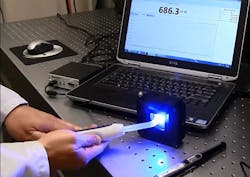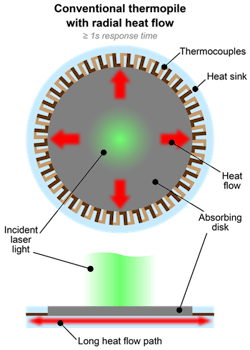SEAN BERGMAN
Rapid, accurate laser power measurements meet high-throughput needs
In nearly every any laser application, it’s necessary to measure laser output power to be able to obtain optimum results. For industrial applications, making power measurements often requires interrupting production and this creates a tradeoff. Specifically, is the cost of stopping or slowing production for laser measurement outweighed by the benefits that making the measurement will deliver? To make this determination, it’s useful to ask some specific questions. These include:
- How sensitive is my process to variations in laser power?
- How fast does my laser output typically change, and therefore, how frequently do I need make a laser measurement to keep my process within specification?
- What is my production throughput? How much bad product will I make, and how much does this scrap cost me, when I delay making a laser measurement for a given amount of time?
- How long does it take to make the laser measurement, and what is the total cost of this measurement in terms of production downtime or manpower?
For high-speed industrial processes based on high-power lasers, the answers to these questions often show that it is not possible to achieve a good tradeoff between measurement frequency and cost. This is because traditional thermopile laser power sensors are relatively slow, so making frequent measurements results in high production downtime. Alternatively, making infrequent measurements can result in high scrap rates.
This situation has now changed with the development of a completely new type of detector that combines the broad wavelength sensitivity, large dynamic range, and high damage resistance of a thermopile, together with the fast response speed of a semiconductor photodiode. This article reviews this technology and how it benefits three different applications.
Thermopile power sensors
Although they are relatively slow, thermopiles have long been used for measuring high-power lasers because high-speed photodiode detectors saturate at low power levels. The typical thermopile consists of a central, light-absorbing disk, a series of thermocouples that surround this disk, and an annular heat sink around the ring of thermocouples. Incident laser energy falls on the absorbing disk and is converted into heat. The heat then flows radially across the thermopile disk to the heat sink, which is held at a near-constant ambient temperature by air or water cooling. The temperature difference between the absorber and heat sink is converted into an electrical signal by the thermocouples. Calibrated electronics in the meter convert this signal into a laser power reading (FIGURE 1).
Thermopile sensors have several advantages, including an extremely broad spectral range, the ability to work over a wide power range, high laser-damage resistance, and uniform spatial response (meaning insensitivity to changes in beam size, position, or shape). The limitation of the technology is that the transfer of heat across the width of the thermopile disk makes this technology inherently slow. It often takes several seconds before the heat flow induced by the laser reaches equilibrium, and the power measurement becomes steady on the display. Physically larger sensors take longer to reach this steady state.
Thin-film thermoelectric technology
Coherent has developed completely new sensor architecture, called thin-film thermoelectric technology, to overcome the speed limitation of thermopiles. Here, the thermoelectric-generating materials are a stack of films that have layer thicknesses on the order of microns. The heat generated by absorbed laser light is able to flow axially very quickly through these thin layers to the heat sink below. The electrical signal from the thin film layers then moves laterally to the edges of the device, where it can be measured the sensor electrodes (FIGURE 2).
This architecture reduces the time constant for the detector into the microsecond range, enabling it to provide an essentially instant power measurement without any overshoot. Coherent’s PowerMax-Pro product based on this technology therefore delivers rapid measurement speed, while still having all the benefits of the traditional thermopile architecture. These include large active area (30 × 30mm), wide dynamic range (50mW to 150W), high damage resistance (14kW/cm2), and broad wavelength range (300nm to 11µm).
The benefits of this new technology are illustrated by three high-power laser applications that originally employed traditional thermopile detectors (in each case, the laser power was too high for direct measurement with photodiodes).
High-power laser diode L/I curves
Diode laser manufacturers typically measure the light output power as a function of drive current (called the L/I curve) for every single device they produce, because users need to know this somewhat variable information to power each device properly. One manufacturer of high-power, near-infrared (NIR) diode laser bars reports that they take a total of about 60 different measurements when characterizing lasers that output in the 50–100W range. Here, the current is increased in a series of small steps, and the output power is measured at each. The manufacturer is looking to determine the threshold current (where lasing first begins), for any kinks or aberrations in the L/I curve, and for the maximum safe drive current. Therefore, they need a detector with enough dynamic range to resolve all the features of the L/I curve at lower powers, yet can still measure all the way to the maximum output of the device.
Using a thermopile detector, the entire measurement sequence—zeroing the sensor, exposing it to the diode, and then letting it read for long enough to get a stable measurement—took about a minute. This meant that a full set of 60 measurements required about an hour.
The nearly instantaneous measurement capabilities of the thin-film thermoelectric detector allow this measurement to be made about 10X faster—literally in just seconds. This dramatically reduces measurement time, and therefore cost, for the manufacturer. And it even enables them to take more individual measurements, if necessary, to measure every detail of the L/I curve.
Fuel injector nozzle drilling
Automobile manufacturers are very focused on producing greener, more efficient engines. They have found that the ability to drill fuel injection nozzles with smaller holes, with more precise control of hole shape and taper, can be important in improving fuel efficiency and reducing carbon emissions. Picosecond pulsewidth industrial lasers have recently emerged as a superior method for drilling these small holes (100–200µm diameter) in steel.
For one fuel injector manufacturer who has built their own picosecond laser-based drilling machine, this high-speed process is sensitive to laser output power. Their machine drills numerous holes each second, so taking it offline to make a power measurement significantly impacts production. However, laser power must be tightly controlled to produce holes at the required precision.
With a thermopile detector, taking a power measurement required moving the optics head away from the work piece to the detector, and keeping it there long enough to get a stable reading. This entire process required about 30s, during which time the system could have drilled many holes.
Now, the company has switched over to a PowerMax-Pro detector. Once again, this has reduced measurement cycle time by about a factor of 10. In fact, the overall measurement time is now so short that measurement can be performed during the natural pause while the mechanical fixtures that hold each set of injector nozzles are moved into place. The end result is the ability to make more frequent measurements, resulting in a more consistent process and reduced scrap while also increasing production throughput.
Dental adhesive curing
Ceramic dental fillings are typically glued into patients’ teeth using adhesive resins that cure when exposed to ultraviolet (UV) light. Curing the resin properly requires that it be exposed to the correct level of total UV power for the right amount of time.
LED-based UV curing lights are usually manufactured in the form of handheld, battery-powered wands. Because LED output is usually increased in a series of discrete steps, fully characterizing the output of the wand requires measuring output from initial power-on until it reaches full power (FIGURE 3).
However, the newest UV curing lights come up to their maximum power much more quickly than earlier models. Thermopile detectors aren’t fast enough to follow this power increase precisely. An attenuator or beamsplitter could be used to reduce the output enough to allow measurement with a photodiode, but this isn’t an ideal solution since it’s very important that the maximum output power of this medical device be correctly certified. This is best accomplished with a direct measurement of LED output, at full power.
The thin-film thermoelectric detector has a rapid enough response speed to measure the exact way in which light output of the LED wand increases from startup. Plus, it can easily measure the full power output of the device without saturating. One LED wand manufacturer has already switched to PowerMax-Pro for these reasons.
Conclusion
As the precision and throughput of laser-based industrial processes increases, the need for more rapid and accurate laser power measurements becomes increasingly important. A new technology meets this need, providing rapid power measurement of high power beams from the UV to the far infrared. Manufacturers who have adopted this technology are seeing increased throughput and improved process control, as well as reduced costs.
ACKNOWLEDGEMENT
PowerMax is a trademark of Coherent.
SEAN BERGMAN([email protected]) is product manager for laser measurement instrumentation at Coherent (Santa Clara, CA); www.coherent.com.


